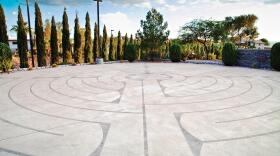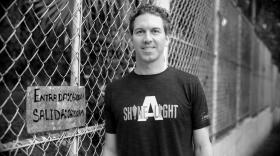Las Vegas is at the national forefront of police-community relations — will that help the city avoid confrontation and violence?
Around five years ago, a white guy, maybe ex-military judging by his haircut and attire, showed up at the Masjid As-Sabur mosque in West Las Vegas, near Bonanza and H Street. He was carrying a box.
“He said, ‘Here, open this,’ and I refused,” says Ahmad Adè, who does community outreach for the mosque. “There were a lot of big black guys there, and he was clearly not afraid. Some of our guys were calling 311, but (the dispatchers) were taking it as a joke.”
Then Adè remembered the previous weekend’s visit by Larry Burns, then-captain of Metro’s Bolden Area Command, where the mosque is located. Burns had given Adè his card and said to call if he ever needed anything. So Adè called Burns and told him about the unnerving man with the box.
“This was a Sunday morning around 7 a.m.,” Adè recalls. “At 7:02, officers were on their way. The guy left, but the response we got after that was incredible. Metro had someone swing by every 20 minutes for the first few hours, and then every hour or so for the next 24 hours. It was a big deal. People saw the benefit of the relationship we had with the police.”
That relationship, forged through years of behind-the-scenes work by both community leaders and law enforcement, has borne fruit both obvious and intangible.
Its roots can be traced back to the months following 9/11, when an African-American advisory committee to the police became the Metro Multicultural Advisory Committee, or MMAC. It pulled in representatives of other communities — Asian, Hispanic, LGBT — and began working with law enforcement on issues of concern.
“For instance, a discussion came up about the gang policy that had existed for 25 years,” says Mujahid Ramadan, a community leader who helped found MMAC and is still involved. “If kids are identified as gang members, they go on a list. You need that information sometimes, but the issue was how the police collected it, what characteristics they were using to identify people, whether people even knew they were on the list.”
MMAC took its concerns to then-Sheriff Doug Gillespie. Together, they formed a group to study the policy, bringing in the district attorney and some judges, and ultimately got it changed. Ramadan remembers six weeks of heated discussions and compromise that left him exhausted.
But the work hasn’t been all unglamorous toil. It’s also community programs like Adopt a Cop, which sends recent police academy graduates in plain clothes to community centers so they can bond with people on their beats before hitting the streets.
Meanwhile, a new type of policing was taking root in Burns’ command. It’s illustrated by an experience then-Sergeant Sasha Larkin and Officer Ivan Chatman had in 2007 when they spotted a drug dealer in the west side neighborhood where he’d become a nuisance to residents.
“So we take off running after him,” Chatman says. “He goes through a mosque. We get to the mosque, and we put the brakes on. We’re like, ‘What do we do? Can we go in? I don’t know. We don’t want to disrespect anybody.’”
They realized there was an important cultural institution on their patrol they knew nothing about. Larkin decided to remedy the situation. After six months of driving by and waving, officers in her unit started talking to members of the mosque (which, Chatman points out, included many ex-convicts). Adè invited the officers in for a tour; they asked what they should do — take off their shoes? Cover their heads? Larkin soon took to showing up for Friday prayers in a hijab.
The work on various fronts came to fruition in the 2012 reforms that the U.S. Department of Justice recommended after Metro’s excessive use of force had the local paper publishing an investigative series and citizen groups threatening to sue. The Review-Journal found that Las Vegas police had shot at seven unarmed people, five of them black, from September 2009 through January 2011, killing one. The Justice Department’s recommended reforms included de-escalation policies and cultural-sensitivity training and resulted in a significant decrease in officer-involved shootings.
Those involved in forging the Metro-community relationship also credit it for shielding Southern Nevada, so far, from the violent confrontations that have wracked other cities since the 2012 death of Trayvon Martin in Florida.
“When Milwaukee happened, I got a call from Undersheriff (Kevin) McMahill,” Ramadan says, referring to protests that erupted after the fatal police shooting of a black man there in early August. The first night’s demonstration led to a Milwaukee gas station and some cars being burned and a police officer getting hit in the head with a brick. There were protests in Las Vegas, too, but like the others that have happened here, they were peaceful.
McMahill has had frequent cause to call Ramadan lately. Two weeks before this issue of Desert Companion went to press, an imam and his assistant were shot and killed as they left their Queens mosque after evening prayers. July saw the killing of two men, Philando Castile in St. Paul, Minnesota, and Alton Sterling in Baton Rouge, Louisiana, both with widely circulated videos that cast doubt on the police actions and reinvigorated Black Lives Matter protests nationwide. Then, eight law enforcement officers were killed by separate lone wolves in Baton Rouge and Dallas.
“Last month, we got hit pretty hard,” says Noble Wray, head of community-oriented policing at the Department of Justice. “With the high–profile incidents that have taken place lately, now is not the time for the police and community to be isolated.”
Wray and others hold up Las Vegas as a model for police reform. But with tensions reaching a boiling point around the country, can the community trust that Metro has built prevent us from being the next Dallas or Milwaukee?
Chatman thinks so. He’s now a sergeant, and Larkin is his lieutenant, in Metro’s community-engagement division. He’s the fusion liaison officer, making him part of the national network set up after 9/11 to improve communication among law-enforcement agencies — all the way up to Homeland Security. In other words, community engagement is a counterterrorism activity.
“This is where we are currently,” Chatman says, pushing a sheet of paper across the desk. It’s an invitation from Adè and a Black Lives Matter organizer to a meeting on July 30 at Masjid As-Sabur, the same mosque where Chatman stopped short nine years ago.
At the meeting, which also included Ramadan and North Las Vegas police and community representatives, the group brainstormed ways to fend off the friction that other cities are experiencing. They came up with an event called Shoot for Peace, Talk for Peace, Party for Peace, featuring a basketball game between NBA legends and cops. It’s set for October 1 at Rancho High School.
“We’ll do a barbecue, have a radio host, and get as many people out as possible,” Adè says. “We want community members and cops talking to each other.”
An evening of b-ball and burgers might not seem like counterterrorism. But after nearly a decade, the organizers believe they’re on the right track.
“It’s the intangibles,” Ramadan says. “We lessen the potential. We can’t say we know it’s never going to happen to us, but we can say we’re doing everything we can to prevent it.”









